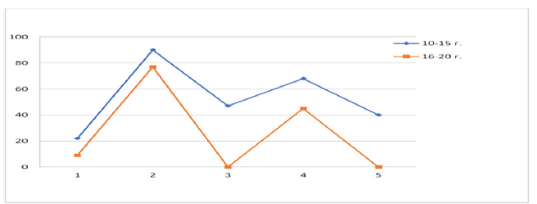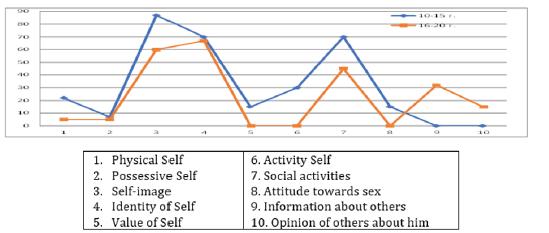- Submissions

Full Text
Psychology and Psychotherapy: Research Studys
Family Etiology of Suicidal Properties in Adolescents
Ivan Dimitrov*
Department of General, Experimental and Genetic Psychology, Faculty of Philosophy, Sofia University “St. Kliment Ohridski”, Bulgaria
*Corresponding author: Ivan Dimitrov, Department of General, Experimental and Genetic Psychology, Faculty of Philosophy, Sofia University “St. Kliment Ohridski”, Bulgaria
Submission: August 01, 2022Published: August 09, 2022

ISSN 2639-0612Volume5 Issue5
Introduction
The subjects were: a total of 27, of which 13 aged 10-15 years and 14 adolescents aged 19-20 years. For this purpose, two methodological tools were used: A method for studying the «genesis of the self-concept»/GPS/ in the version of the Canadian psychologist /L’Ecuyer, 1978/ and the method of French psychologists / M. Borelli et R. Perron, 1967 / for studying values [1,2] (Figure 1). Two of the constructs of the «Self-concept»-»Adaptive Self» and «Self-not-Self» for adolescents are at the lowest level. We will pay attention to only two substructures of the «Adaptive Self»: «Self-Value» and «Self-Activity», the meanings of which lie on the abscissas, i.e., with zero valence (Figure 2). Microanalysis of the data at the most specific level of the «Self-concept» showed that there were no meanings of such equivalents or categories as «personal value», «way of life», «identification with other people», «adaptation strategies» and others. It is interesting that in adolescents the structure of the «Adaptive Self» is completely absent. Bearing in mind that it is precisely from the age of 10-15 to 19-20 years that a sharp increase in suicide attempts is observed, we suggest that one of its explanatory reasons lies in the weakness of the mechanisms of the «Adaptive Self», which opens the way to self-destruction and the thought of it becomes acceptable and natural to the adolescent [3].
Figure 1:Frequency of “Self-concept” structures in the studied adolescents.

Figure 2:Frequency of self-concept substructures in adolescents.

The decline in the level of the «Self», the loss of its motivating force in the life of adolescents, the lowering of the level of selfrespect and self-acceptance ultimately block the activity of this «core» of the personality, and it, naturally, finds itself on the threshold of hopelessness and despair. There are no internal obstacles in front of her, and the external ones are psychologically insufficient or completely inactive due to the disharmony in the social relations between the adolescent and the significant people surrounding him i.e., they all generally speak of inner fragmentation and disharmony with oneself, of a deficit of satisfying interpersonal communication, of a weakness of «self-worth», of depression, despair, and loneliness. Data on values also testify to the absence of emotional-personal communication between parents and children, to the lack of satisfactory contacts with them, with the help of which children could integrate into the family structure, socialize and feel their value to parents. Thus, the obtained data, although on an extremely small studied population of adolescents, allow to believe that the weakness or absence of the mechanisms of the «Adaptive Self», unfavorable relations with close adults and with peers can appear as factors for suicidal attempts at this age.
These data mark the next path of the «eroding» personality process: 1. In the area of self-awareness, the individual begins to ignore the perceptions and findings about himself, which gradually leads to the disintegration of the unity between the real and the ideal «Self»; 2. Instead of active intervention in his own life, the individual in such a state «slides» to a passive contemplative position in relation to the data of self-knowledge; 3. From here, it is possible that the observed sometimes paradoxical at first glance among adolescents «cry» for strength and courage; 4. They then lose their notions of a benchmark, a measure, and a standard against which they could determine their conformity/nonconformity to social expectations, prescriptions, and demands upon them. And this inevitably complicates their orientation to their own place among the surrounding adults and peers, in its value to them; 5. Ultimately, the individual’s life begins to flow without initiative and active goal setting, without organization, without connection to present realities and without a plan for the future.
In a state of such a “personal and existential vacuum” (Frankl) and with constant, immediate demands from the environment or with unfavorable relations with it, such individuals do not feel the strength in themselves to cope with the challenges of life and undertake what F. Schiller expressed with the words: «Better a terrible end than endless fear». Preventive work with such adolescents should begin with raising the level of their «Self», involving them in real activities and relationships, certifying their competence and testifying their value to themselves and to other people - parents, teachers, and peers. At the same time, bearing in mind the multiplicity of symptoms, the probability that each one of them means very different disturbances of the personality, always and in each individual case, specialists are obliged to look for their specific organization, as close as possible to explaining each specific case, in order to select the optimal means to help adolescents choose life over death.
References
- Borelli M, Perron R (1967) Value systems and self-representation. French Psychology 12(2): 124-132.
- Dimitrov Ivan (2009) Children and adolescents in crisis. Prosveta Publishing House, Germany, pp. 1-207.
- L’Ecuyer R (1978) The concept of self. Presses Universitaires de France, France, pp. 1-230.
© 2022 Ivan Dimitrov, This is an open access article distributed under the terms of the Creative Commons Attribution License , which permits unrestricted use, distribution, and build upon your work non-commercially.
 a Creative Commons Attribution 4.0 International License. Based on a work at www.crimsonpublishers.com.
Best viewed in
a Creative Commons Attribution 4.0 International License. Based on a work at www.crimsonpublishers.com.
Best viewed in 







.jpg)






























 Editorial Board Registrations
Editorial Board Registrations Submit your Article
Submit your Article Refer a Friend
Refer a Friend Advertise With Us
Advertise With Us
.jpg)






.jpg)














.bmp)
.jpg)
.png)
.jpg)










.jpg)






.png)

.png)



.png)






